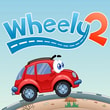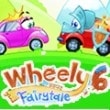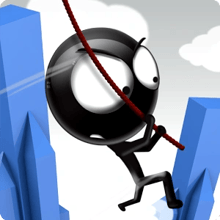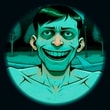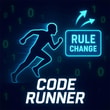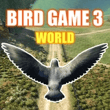The city is a sketch made of lines and distance, and you are a dot that refuses to stay still. Rope n Fly 4 is momentum turned into a toy, a clean physics playground where a tap becomes a grapple, a release becomes flight, and every building is just another sentence in a story you write with timing. You swing, you let go a heartbeat early or late on purpose, you catch the next anchor like a thief grabbing a ledge, and the street below turns from danger into rhythm. Nothing here hides behind menus. It is you, gravity, and a skyline that keeps daring you to think a little farther ahead than your fear usually allows.
🪢 Line tight arc right
The first skill is faith in the curve. A rope does not pull you straight, it teaches you how to travel in circles that pretend to be lines. Tap to fire a tether, feel the slack become tension, and let the arc carry you until the line is almost vertical. Release then, not when panic says so. That last fraction of a swing is where speed lives. Too early and you pop into the air like a startled bird. Too late and you scrape windows with comedic regret. After a handful of swings your thumb starts hearing the right beat, and suddenly a row of ordinary buildings turns into a clean melody of launches and landings you did not know you could play.
🏙️ City as a metronome
Skyscrapers are not obstacles; they are instruments. Tall towers gift long, lazy arcs that let you store speed like a secret. Short blocks demand quick hooks and faster releases, small improvisations that keep momentum warm. Street lamps and cranes become emergency anchors when a plan misfires. Billboards tempt you to tag a flashy midair grab just to prove your timing is real. The layout never stops telling you how to move. Shadows hint at depth, rooftop edges suggest safe catch zones, and the spaces between buildings whisper which angles will pay you back two swings from now.
⚖️ Momentum is a promise you keep
Rope n Fly 4 is kinder than it looks because it always respects conservation. The more you bend your arc toward the horizontal just before release, the more of your speed turns into forward glide rather than useless height. Tuck on the way down to rotate a hair faster, extend as you rise to buy yourself a wider catch window. These are tiny, almost invisible choices, and they turn chaos into control. Miss by a little and the ground forgives you if you roll your next hook early. Hit perfectly and the skyline blurs while your brain keeps time with your thumbs.
💥 Risk buys style and score
You can play safe, kiss rooftops, pad landings, and methodically chain hooks to reach the far end of the map. Or you can flirt with disaster and get paid. Near misses squeeze extra points from the air. Low sweeps over traffic pump the heart and the multiplier. Threading a gap between two signs without touching a pixel is a victory you feel in your teeth. The game does not demand showboating, but it celebrates it honestly. When you nail a reckless sequence and stick the catch, the pause you take after to grin is the real reward.
🎯 Tiny habits that change everything
Look one building ahead, not at the hook you are about to throw. Fire slightly above the ledge you want so the rope grabs with useful angle instead of a dead hang. Release at bottom dead center plus a blink to convert drop into drive. If you bungle a swing and float, do not panic tap the next anchor high and allow the rope to pull you back into a path that intersects the line you lost. Think diagonals. A sideways catch across the street often sets a better next arc than a vertical grab above your head. These micro habits do not read like tips so much as micro truths the game keeps reminding you with every clean run.
🚀 Boosts, gadgets, and graceful saves
Depending on mode, you may pick up little helpers that nudge momentum without breaking the physics. A brief speed burst stretches a good release into a great glide if you trigger it at the very bottom of a swing. A slow motion pulse buys you a tiny window to place a clutch hook when the screen gets busy. Occasional double hooks let you slingshot between close anchors with a rhythm that feels like drumming on the skyline. None of these replace skill; they reward intention. Spend them to keep flow. Save them to rescue a misread. The smartest runs use tools like punctuation rather than paragraphs.
🧠 Reading failure like a coach
When you hit asphalt, the lesson is immediate and useful. You released late and bled speed against a wall. You attached too high and turned your arc into a pendulum that went nowhere. You chased height for style when the next building needed a flat approach. Rope n Fly 4 never hides the why. That clarity keeps frustration tiny. You reset, you make one adjustment, and the next attempt carries farther. Improvement is loud and visible. Yesterday’s reckless gap becomes today’s reliable line. That is the good stuff.
🎮 Controls that tell the truth
Tap to latch, hold to sustain, release to fly. The responsiveness is crisp, so mistakes belong to the person holding the device, not to a button that pretended to listen. On mobile the hitboxes are generous enough to let bold grabs land without pixel hunting. On desktop with a mouse or keys, the pointer snaps to anchors with just the right magnetism to feel fair. The feedback is tactile in tiny ways: a subtle stretch sound when tension peaks, a soft snap when the rope releases at speed, a clean chime when a risky line pays with extra points. Your hands learn as much from the audio as from the arc on screen.
🌆 Modes for your mood
If you want meditative flow, the calmer mode lets you surf the skyline without a clock barking. If you crave pressure, timed or challenge runs push you to score aggressively and force decisions that make your heart negotiate with your thumbs. Distance marathons teach patience and efficient lines; stunt hunts spotlight bravado and window threading. Swapping modes feels like changing playlists with the same favorite instrument.
🎨 Style that lives in motion
The art is minimalist and helpful. Strong silhouettes keep anchors readable at speed. Background layers parallax just enough to sell height without clutter. The city color shifts through afternoon into neon dusk and back, and your rope draws little arcs of light that make your path a sketch you can admire for half a second before the next jump. It is the right kind of pretty, the kind that makes timing easier rather than stealing attention.
📈 From first swing to fluent
Your opening minutes are wobbly and charming. You catch too high, drop too soon, and laugh your way down the block. Ten minutes later your releases sound like you meant them. Twenty minutes later you start recognizing building families and routing them with a confidence that would have surprised your earlier self. You notice that the same three move sequence carries you across entire neighborhoods, and you invent a signature flourish at the end of a long glide because you know exactly how to reattach without losing speed. That arc from clumsy to fluent is the reason to return.
💡 Endgame polish for perfection chasers
If you are chasing leaderboards or personal bests, shrink your movements. Shorten the time between peak tension and release so your exit angle stays flat and fast. Use slight downward hooks on the far side of a roof to turn a catch into an automatic “pump” that gifts free speed. Practice emergency anchors on low street fixtures to rescue botched jumps without hard resets. Learn one advanced pattern for short blocks triple tap catch release catch that turns a choppy street into a smooth wave. These refinements feel like magic when they click and they keep the game fresh long after you know every skyline mood.
Open Rope n Fly 4 on Kiz10 and give the city a reason to look up. One clean hook, one patient release, one perfect glide across a row of windows and you will understand why this simple physics toy owns so many five minute breaks. Swing, smile, repeat, and let momentum do what it does best carry you farther than you expected.
 Rescue from Rai
Rescue from Rai






